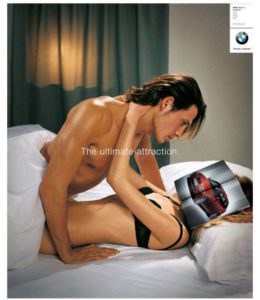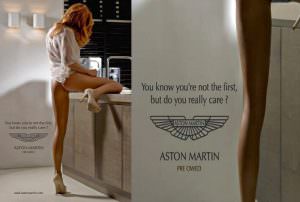The advertising world has long been the bastion of the objectification of women. Adverts employ women as shiny, glittery, sexy objects that make ordinary consumer products, like mango juice, office chairs, and chocolate, infinitely more glamorous. Prominent amongst these advertisements are the those by car companies.
The automobile industry has treated women as mere props that aid the glamorisation of their cars. BMW India just took it a step further by releasing a commercial about their “Gesture Control” feature, which announced not just the new feature but how they really like their women – beautiful, silent, and under a man’s control. Take a look at the ad, which manages to convey all of patriarchy’s guiding principles in 40 short seconds.
Gesture Control on the new BMW M760Li xDrive lets you get your point across with simple hand movements. Learn more – https://t.co/6zrSQsHJMQ pic.twitter.com/KF9pVLBNRr
— BMW India (@bmwindia) May 18, 2017
BMW India directly compares a woman and a car – objectification 101, anyone? The description underneath the ad on YouTube reads, “Heat and motion sensors recognise five different gestures to control volume, incoming calls and more.”
BMW India, with this 40-second commercial, establishes how women are always yelling and offers men the magical power of controlling them with one simple gesture.
https://twitter.com/gauravlavania/status/869442983237529604
Thank you, BMW, for all the respect, but you ought to know there’s a huge difference between a living, breathing, thinking woman and an inanimate object that can be controlled via gestures. Women are not a man’s possession to be treated as he pleases.
This isn’t the first time BMW India has released sexist advertisements. In March this year, BMW India had released a Women’s Day ad to “celebrate women” as the embodiment of grace, trendsetters, visionaries and the driving force! The advert however, only features a slow moving car displaying all the traits that a woman apparently embodies. So the ad, in the name of empowered women, again reduces a woman to an object – more specifically a car (which doesn’t even have a woman driving it!)
What’s worse than sexist ads? Sexist ads that are apparently tributes to empowered women.
Also Read: Femvertising – How Corporates Co-Opt Feminism To Sell Us Things
In any case, Women’s Day has long since passed and it’s back to reality, everybody! BMW is no longer making efforts – though blundering – to commend women. No, for BMW, women are no longer trendsetters, visionaries and the driving force, but simply a source of noise that needs to be muted.
However, it wouldn’t be fair to call out BMW alone. Car companies have released a surplus of sexist ads over the years, equating women with cars, and in some cases pronouncing cars to be better even!
For instance, this Ola ad told men to take Ola micros, which were cheaper on the mileage than demanding girlfriends in shopping malls. Feminism in India demanded the ad be pulled down on Twitter (and received a lot of backlash for it), after which Ola thankfully, did take the ad down.

Source: Rajnikant V/s CID Jokes
Car companies often use women as a tool to market to the male consumers, with ads that tend to use women’s bodies to cater to the male gaze and employ sexual innuendos that objectify and demean women. Here is another gem by BMW, where a man looks at a car magazine that’s plastered over his girlfriend’s face, as he has sex with her. Because what are words like women’s pleasure, respect or consent? Conspiracies invented by feminists of course!

Source: Twitter
While BMW associates sexual attraction towards a woman with being attracted to a car, here’s Aston Martin selling pre-owned cars by degrading women. “You know you’re not the first, but do you really care?” reads the tagline of this advert, blatantly marketing its product by depicting women as if they are an object to be used. There is also the not-so-subtle slut-shaming aspect of the advert, where a conventionally attractive woman must be sexually promiscuous, and willing to be “used”.

Source: mgoblog.com
Meanwhile, Mazda tries to get its audience excited for its sale by using the picture of a naked woman. Can someone please tell me why was there a need for a naked woman in this advert at all?

Source: proffesorx.wordpress.com
And then there’s this Ford ad that caused an (understandable) uproar. The ad featured scantily dressed women being gagged and kidnapped in the trunk of a Ford car. This atrocious ad normalises crimes against women, and moreover uses women in positions of distress and victimhood to lure men into buying the product! If this isn’t rape culture, I don’t know what is. Even worse, this ad was released in March 2013, a few short months after the December 2012 Delhi rape case, when the nation was clamouring to increase women’s security.

Source: The Telegraph (UK)
Car companies continue to objectify women to sell to the male consumers, which in itself is an issue. A car is not a gendered object, so why market to only one gender? Do women not drive? One can only hope that car companies soon realise the latent motives behind their ads and understand the consequences they have.
Ads like these also point to the negative consequences of having mostly all-male advertising teams, where abhorrent ads like this are approved without a second glance. This is why we need more women in senior advertising positions that will hopefully mitigate the flood of sexist imagery coming our way in advertisements every day.
About the author(s)
Shagun Gupta is a fiction enthusiast and an amateur photographer, currently embarking on a writing career after having recently earned her post-graduate degree in Mass Communication.




